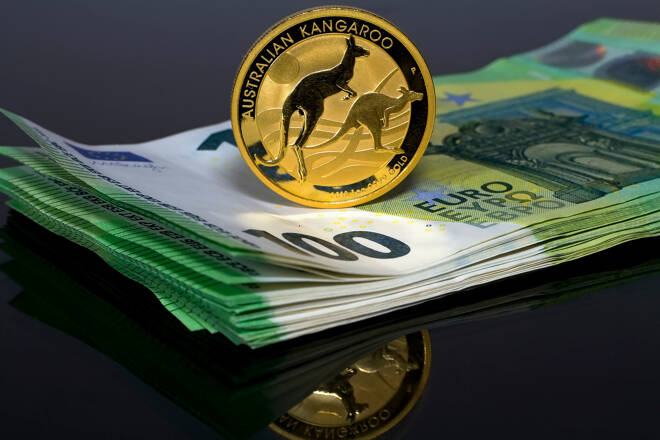Advertisement
Advertisement
AUD/USD Daily Forecast: Will US Data Support a Push to $0.67500?
By:
Key Points:
- RBA’s hawkish stance on inflation drove AUD/USD up 0.86% on Friday, with a focus on interest rate differentials.
- Expert views on the labor market and a hawkish RBA rate path support an AUD/USD target near $0.70.
- Upcoming US LEI and FOMC speeches could influence AUD/USD trends, with eyes on $0.67500
In this article:
The AUD/USD rallied 0.86% on Friday, August 16, closing at $0.66266. Investor bets on a narrowing in interest rate differentials between Australia and the US drove Aussie dollar demand.
Aussie Inflation and the RBA Rate Path
On Friday, August 16, RBA Governor Michele Bullock testified before the Australian House of Representatives Standing Committee. In her opening statement, Governor Bullock discussed inflation extensively, stating,
“Underlying inflation, which abstracts from volatile components of the index, is also still elevated at 3.9 per cent in June 2024. This remains too high. Our current forecasts have underlying inflation by the end of this year still sitting around 3.5 per cent.”
About the interest rate trajectory, the RBA Governor added,
“We did not increase interest rates as much as some other central banks. And we have received some criticism for that. Indeed, some commentators continue to call for further tightening in monetary policy.”
Governor Bullock also said,
“We have been trying to balance bringing inflation back down over a reasonable timeframe, without inflicting unnecessary damage on the labor market. And the Board’s judgment to date has been that policy is currently sufficiently restrictive to do that. […] based on what the Board knows at present, it does not expect that it will be in a position to cut rates in the near term.”
The RBA’s hawkish stance suggested a narrowing of the interest rate differential between Australia and the US.
On Tuesday, August 20, the RBA Meeting Minutes may reveal how close board members were to hiking rates. Since the interest rate decision, labor market data supported a hawkish monetary policy stance.
Expert Views on the Labor Market and the RBA Rate Path
AMP Head of Investment Strategy and Chief Economist Shane Oliver recently commented on the Aussie Labor Report, stating,
“Aust unemp now at its highest since Nov 2021. With the rise in unemp due to rising in labour supply, it’s not as bad as a rise in unemp on the back of job losses. So, it won’t rush the RBA into rate cuts. But it’s still a cooling in the labour mkt & we see the first cut in Feb 2025.”
Tight labor market conditions may support wage growth, fueling consumer spending and demand-driven inflation. A higher-for-longer RBA rate path could raise borrowing costs, impacting disposable income and consumer spending.
The RBA’s hawkish stance contrasts with expectations of multiple 2024 Fed rate cuts. Expectations of a narrowing in the interest rate differential could push the AUD/USD toward $0.67500.
US Economic Calendar
On Monday, August 19, the US Conference Board Leading Index (LEI) will be in focus. Economists forecast a 0.3% decline in July, following a 0.2% drop in June.
Weaker-than-expected numbers may challenge investor expectations of a soft US economic landing, possibly supporting an AUD/USD move toward $0.67500. The LEI provides insights into the US economic outlook, influencing the Fed rate path.
The Conference Board, Business Cycles Indicators, Senior Manager Justyna Zabinksa-La Monica commented on the June report, stating,
“June’s data suggest that economic activity is likely to continue to lose momentum in the months ahead. We currently forecast that cooling consumer spending will push US GDP growth down to around 1 percent (annualized) in Q3 of this year.”
FOMC Member Speeches Crucial for the AUD/USD Pair
Beyond the numbers, investors should also monitor FOMC member speeches. On Monday, FOMC voting member Christopher Waller is on the calendar to speak.
His views on the US economy, labor market, and the Fed rate path will likely influence US dollar demand. In July, Waller suggested favorable CPI Reports could allow a rate cut soon. Deviation from his previous comments could move the dial as the markets expect multiple 2024 Fed rate cuts.
Short-Term Forecast: Bullish
Near-term AUD/USD trends will depend on the US LEI and central bank guidance. Weaker-than-expected US stats and dovish Fed signals could support an AUD/USD move toward $0.67500. The hawkish RBA may also push the pairing toward $0.67500 as monetary policy divergence favors the Aussie dollar.
Investors should remain alert, with economic indicators and central bank commentary influencing AUD/USD price trends. Monitor the real-time data, news updates, and expert commentary to adjust your trading strategies.
Stay updated with our latest views and analysis to manage exposures to the forex markets.
AUD/USD Price Action
Daily Chart
The AUD/USD sat above the 50-day and 200-day EMAs, sending bullish price signals.
A break above the $0.67003 resistance level would support a move toward $0.67500. Furthermore, a breakout from $0.67500 would bring the $0.67967 resistance level into play.
Investors should consider the US LEI and Fed commentary require on Monday.
Conversely, a drop below the top trend line could signal a fall toward the 50-day and 200-day EMAs. A fall through the EMAs could give the bears a run at the $0.65760 support level.
With a 14-period Daily RSI reading of 59.85, the Aussie dollar could break above the $0.67003 resistance level before entering overbought territory.
About the Author
Bob Masonauthor
With over 20 years of experience in the finance industry, Bob has been managing regional teams across Europe and Asia and focusing on analytics across both corporate and financial institutions. Currently he is covering developments relating to the financial markets, including currencies, commodities, alternative asset classes, and global equities.
Latest news and analysis
Advertisement
